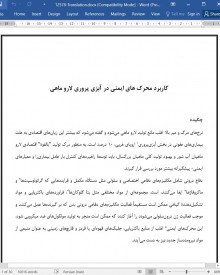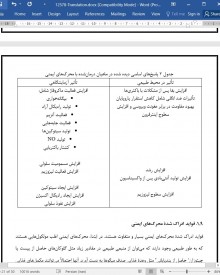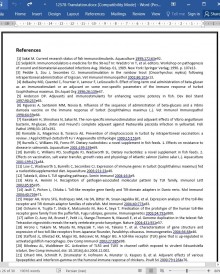
دانلود مقاله کاربرد محرک های ایمنی در آبزی پروری لارو ماهی
چکیده
نرخهای مرگ و میر بالا اغلب مانع تولید لارو ماهی میشود و گفته میشود که بیشتر این زیانهای اقتصادی به علت بیماریهای عفونی در بخش آبزیپروری اروپای غربی، 10 درصد است. به منظور درک تولید "بالقوة" اقتصادی لارو ماهیان آب شور و بهبود تولید کلی ماهیان بزرگسال، باید توسعة راهبردهای کنترل بار عامل بیماریزا و معیارهای ایمنی- پیشگیرانه بیشتر مورد بررسی قرار گیرند.
دفاع درونی شامل مکانیزمهای دفاعی اختصاصی و سلولی مثل دستگاه مکمل و فرایندهایی که گرانولوسیتها و ماکروفاژها ایفا میکنند، است. مجموعهای از مواد مختلفی مثل بتا گلوکانها ، فراوردههای باکتریایی و مواد تشکیلدهندة گیاهی ممکن است مستقیماً فعالیت مکانیزمهای دفاعی درونی بدن که بر گیرندهها عمل میکنند و موجب فعالیت ژن درونسلولی میشوند را آغاز کنند که ممکن است منجر به تولید مولکولهای ضد میکروبی شود. این محرکهای ایمنی اغلب از منابع باکتریایی، جلبکهای قهوهای یا قرمز و قارچهای زمینی به عنوان منبعی از مواد نیرومندساز جدید نیز به دست میآیند.
کاربرد محرکهای ایمنی، به عنوان مکملهای غذایی میتواند موجب بهبود دفاع داخلی جانوران با فراهم آوردن مقاومت در برابر عوامل بیماریزا در طول دورههای استرس بالا مثل رقمبندی ، تولیدمثل، انتقال به دریا و واکسیناسیون شود. تعدیل ایمنی ماهیان لاروی به عنوان روشی احتمالی برای بهبود بقای لاروی با افزایش پاسخهای درونی رشد جانوران تا زمانی که پاسخ ایمن سازگارانة آنها برای ارائة یک پاسخ مؤثر به عامل بیماریزا به اندازة کافی رشد کرده باشد، پیشنهاد شده است. برای این منظور، پیشنهاد شده که ارائة محرکهای ایمنی به عنوان یک مکمل غذایی برای ماهیان لاروی میتواند سود قابل توجهی در تقویت دفاعهای درونی با زیان اندک به حیوان در حال رشد داشته باشد. در مقابل، تصوراتی وجود دارد که موضوع تعدیل ایمنی یک جانور زهپا را پیش از تشکیل کامل دستگاه ایمنیاش مطرح میسازد چرا که ممکن است تأثیر معکوسی بر توسعة یک پاسخ ایمنی طبیعی داشته باشد.
1.مقدمه
1.1. محرکهای ایمنی در آبزیپروری تجاری
با توجه به پژوهش ساکائی (1999) محرکهای ایمنی را میتوان بسته به منابعشان به چند گروه تقسیم کرد که عبارتند از: عوامل باکتریایی، برگرفته از جلبک، برگرفته از حیوان، غذایی به عنوان محرکهای ایمنی و هورمونها یا سیتوکینها .
این گروهبندی فرعی مستقل از روش عملکردشان است. تعریف قبلی محرکهای ایمنی که سلولهای هدف را برای آنکه یک دستگاه بیگانهخوار تکهستهای باشند، محدود میکنند را تنها باید با توجه به اکتشافات اخیر گیرندههای تشخیص الگو (PRR ها) مجدداً توصیف کرد. گلبولهای سفید مختلف ممکن است PRR های مختلفی داشته باشند و ممکن است بسته به گیرندة پیوند دهنده و رویدادهای علامت دهندة درونسلولی موجب پاسخهای ایمنی متفاوتی شوند. در نتیجه، تعریف جدید باید تمامی عناصر دستگاه ایمنی را شامل شود و این تعریف میتواند بدین صورت باشد "یک محرک ایمنی، ترکیبی است که به طور طبیعی وجود دارد و دستگاه ایمنی را با افزایش مقاومت میزبان در برابر بیماریهایی که در بیشتر شرایط به علت عوامل بیماریزا هستند، تعدیل میکند". اگرچه شواهدی در مورد کاربرد سودمند محرکهای ایمنی در آبزیپروری وجود دارد، محصولات تجاری کنونی همانند گلوکانهای β1-3، β1-6 ، از نظر فرمولبندیشان که از ییست گرفته شدهاند، محدود هستند و تحت دامنة MacroGuard محصولات مثل درجة غوطهوری MacroGard®، MacroGard® AquaSol یا کمککنندة MacroGard® فروخته میشوند. محرک ایمنی تجاری موفق دیگر، Ergosan است که از یک وعدة غذایی جلبک دریایی سرشار از آلژیناتها و پلیساکاریدها ساخته شده است. دُز تنهایی از 1 میلیگرم Ergosan به طور چشمگیری سهم نوتروفیلها را زیاد کرده، موجب افزایش درجة بیگانهخواری، فعالیت انفجار تنفسی و نمود interleukin-1β (IL-1β)، interleukin-8 (IL-8) و یکی از دو ایزوفرم شناخته شدة عامل آلفای نکروز تومور ماهی قزلآلا (TNF-α) در گلبولهای سفید صفاقی در طی 1 روز پس از تزریق شد. پارامترهای ایمن اختصاصی در برابر استعمال درون صفاقی Ergosan با تحریک تکمیلی که تنها در گروه 1 میلیگرم درمان شده در طی 2 روز پس از تزریق مشهود بود، کمتر پاسخگو هستند.کاربرد محرکهای ایمنی در فرمولهای واکسن مخصوصاً گلوکانهای β1-3، β1-6 ، دست کم به صورت آزمایشگاهی، در زمان استفاده برای جایگزینی کمک کنندههای روغنی، بدون تأثیرات جانبی معکوسی که در مورد این انواع کمککنندهها یا در جمع با آنها گزارش شدهاند، پاسخهای آنتیبادی بسیار خوبی را ارائه داده است.
2. نتیجهگیریها
با اکتشافات گیرندههای تشخیص الگو، تأثیرات زیستی چند محرک ایمنی مورد بررسی قرار گرفتهاند. اگرچه، فعال شدن ژن خروجی و تولید سیتوکینهای پیشالتهابی حاصل مورد بررسی قرار گرفتهاند، پژوهشهای زیادی باید انجام شوند تا به تأثیرات محرکهای ایمنی با توجه به رابطة ساختار و فعالیت و تأثیرات جهانی که محرکهای ایمنی ایجاد میکنند، قاعده و نظم بدهد. در بیشتر موارد، بسیاری از رویدادهای علامتدهندة درونسلولی که مثلاً به حفاظت از بیماری به علت محرک ایمنی خاصی میانجامند، باید به طور کامل شرح داده شوند. بسیاری از محرکهای ایمنی که در آزمایشات ماهیان مورد استفاده قرار گرفتهاند، موجب تأثیرات سودمندی مثل حفاظت در برابر بیماری به علت افزایش پاسخهای سلولی و هورمونی میشوند. اگرچه، باید در مورد موضوعاتی مثل شکیبایی، اثرات جانبی ناخواستهای مانند سرکوب ایمنی با استفاده از دُزهای بسیار بالای محرکهای ایمنی یا تأثیرات نامطلوب به علت کاربرد طولانیمدت چنین ترکیباتی، محتاط بود. امید است که بعد از توسعة ابزارهای ژنومیک و پروتئومیک مربوط به چند گونه ماهی، بسیاری موضوعات در مورد توجه خاص به قطبش پاسخ ایمنی پس از پیوند گیرندة محرکهای ایمنی، نامعلوم خواهد بود.
Abstract
The production of fish larvae is often hampered by high mortality rates, and it is believed that most of this economic loss due to infectious diseases is ca. 10% in Western European aquaculture sector. The development of strategies to control the pathogen load and immuno-prophylactic measures must be addressed further to realise the economic “potential” production of marine fish larvae and thus improve the overall production of adult fish.
The innate defence includes both humoral and cellular defence mechanisms such as the complement system and the processes played by granulocytes and macrophages. A set of different substances such as β-glucans, bacterial products, and plant constituents may directly initiate activation of the innate defence mechanisms acting on receptors and triggering intracellular gene activation that may result in production of anti-microbial molecules. These immunostimulants are often obtained from bacterial sources, brown or red algae and terrestrial fungi are also exploited as source of novel potentiating substances.
The use of immunostimulants, as dietary supplements, can improve the innate defence of animals providing resistance to pathogens during periods of high stress, such as grading, reproduction, sea transfer and vaccination. The immunomodulation of larval fish has been proposed as a potential method for improving larval survival by increasing the innate responses of the developing animals until its adaptive immune response is sufficiently developed to mount an effective response to the pathogen. To this end it has been proposed that the delivery of immunostimulants as a dietary supplement to larval fish could be of considerable benefit in boosting the animals innate defences with little detriment to the developing animal. Conversely, there is a school of thought that raises the concern of immunomodulating a neotanous animal before its immune system is fully formed as this may adversely affect the development of a normal immune response.
1. Introduction
1.1. Immunostimulants in commercial aquaculture
According to Sakai [1] immunostimulants can be divided into several groups depending on their sources: bacterial, algae-derived, animal-derived, nutritional factors as immunostimulants, and hormones/ cytokines.
This sub-grouping is independent of their mode of action. A former definition of immunostimulants that restricted the target cells to be mononuclear phagocyte system [2] only should be redefined in view of recent discoveries of the pattern recognition receptors (PRRs). Different leucocytes may possess different PRRs and may bring about different immunological responses dependent on the binding receptor and intracellular signalling events. As such, a new definition must include all elements of the immune system and the definition could be ‘‘An immunostimulant is a naturally occurring compound that modulates the immune system by increasing the host’s resistance against diseases that in most circumstances are caused by pathogens’’. Although there is evidence for the beneficial use of immunostimulants in aquaculture, current commercial products are rather restricted in their formulation being derived from yeast, as in the case of b1-3, b1-6 glucans and sold under the Macroguard range of products e.g. MacroGard Immersion Grade, MacroGard AquaSol or MacroGard Adjuvant. Another successful commercial immunostimulant is Ergosan which is made from a seaweed-based meal rich in alginates and polysaccharides. A single dose of 1 mg of Ergosan significantly augmented the proportion of neutrophils, increased the degree of phagocytosis, respiratory burst activity and expression of interleukin-1b (IL-1b), interleukin-8 (IL-8) and one of the two known isoforms of trout tumour necrosis factor-alpha (TNF-a) in peritoneal leucocytes at 1 day post-injection [3]. Humoral immune parameters were less responsive to intraperitoneal Ergosan administration with complement stimulation only evident in the 1 mg treated group at 2 days post-injection [3]. The use of immunostimulants in vaccine formulations especially the b1-3, b1-6 glucans, experimentally at least, has given very good antibody responses when used either to replace oil based adjuvants, without the adverse side effects that have been reported for these types of adjuvants, or in addition to them [4e8].
2. Conclusions
With the discoveries of pattern recognition receptors the biological effects of a few immunostimulants have been studied. Although the output gene activation and the resulting production of pro-inflammatory cytokines have been studied there remains much research to systematise the effects of immunostimulants with regard to structureeactivity relationship, and the global effects the immunostimulants induce. In most cases, many intracellular signalling events that lead to e.g. disease protection caused by a certain immunostimulant have to be defined properly. Inevitably, many immunostimulants used in fish experiments induce beneficial effects such as disease protection due to increased cellular and humoral responses. However, cautions have to be taken regarding issues such as tolerance, non-wanted side effects such as immunosuppression using too high doses of immunostimulants or non-desirable effects caused by a prolonged use of such compounds. It is hoped that following the development of genomic and proteomic tools for several fish species, many issues with special attention to immune response polarisation after receptor binding of immunostimulants will be unveiled.
چکیده
1.مقدمه
1.1. محرکهای ایمنی در آبزیپروری تجاری
1.2. گیرندههای مربوط به محرکهای ایمنی
1.2.1. گیرندة 1 ناقوسمانند
1.2.2. گیرندة 2 ناقوس مانند
1.2.3. گیرندة 3 ناقوس مانند
1.2.4 گیرندة 4 ناقوس مانند
1.2.5. گیرندة 5 ناقوس مانند
1.2.6. گیرندة 6 ناقوس مانند
1.2.7. گیرندة 7 ناقوس مانند
1.2.8 گیرندة 8 ناقوس مانند
1.2.9. گیرندة 9 ناقوس مانند
1.3. پاسخهای ایمنیشناختی پس از تحریک ایمنی
1.4. فواید و "معایب" استفاده از محرکهای ایمنی در آبزیپروری لارو ماهیان
1.5. خطرات و فواید استفاده از محرکهای ایمنی در آبزیپروری
1.6. ارائة محرکهای ایمنی به ماهیان لاروی
1.7. کاربرد محرکهای ایمنی در ماهیهای (لاروی) به صورت ایمنیشناختی بالغ و نابالغ
1.8. فواید نظری
1.9. فواید ادراک شدة محرکهای ایمنی
1.10. راهبردهای مربوط به کاربرد محرکهای ایمنی در ماهیان به لحاظ ایمنیشناختی بالغ
1.11. راهبردهای مربوط به استفاده از محرکهای زیستی در ماهیان به لحاظ ایمنیشناختی نابالغ
2. نتیجهگیریها
منابع
Abstract
1. Introduction
1.1. Immunostimulants in commercial aquaculture
1.2. Receptors for immunostimulants
1.2.1. Toll-like receptor 1
1.2.2. Toll-like receptor 2
1.2.3. Toll-like receptor 3
1.2.4. Toll-like receptor 4
1.2.5. Toll-like receptor 5
1.2.6. Toll-like receptor 6
1.2.7. Toll-like receptor 7
1.2.8. Toll-like receptor 8
1.2.9. Toll-like receptor 9
1.3. Immunological responses following immunostimulation
1.4. Benefits and ‘‘non-benefits’’ using immunostimulants in fish larval aquaculture
1.5. Risks and benefits using immunostimulants in aquaculture
1.6. Delivery of immunostimulants to larval fish
1.7. The use of immunostimulants in immunologically mature and immunologically immature (larval) fish
1.8. Theoretical benefits
1.9. Perceived benefits of immunostimulants
1.10. Strategies for the use of immunostimulants in immunologically mature fish
1.11. Strategies for the use of immunostimulants in immunologically immature fish
2. Conclusions
References
- اصل مقاله انگلیسی با فرمت ورد (word) با قابلیت ویرایش
- ترجمه فارسی مقاله با فرمت ورد (word) با قابلیت ویرایش، بدون آرم سایت ای ترجمه
- ترجمه فارسی مقاله با فرمت pdf، بدون آرم سایت ای ترجمه



